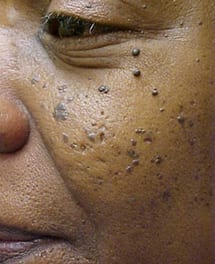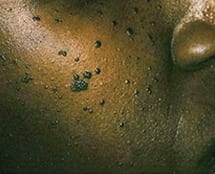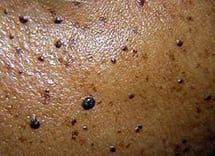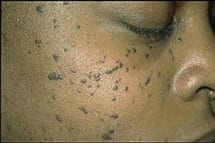Dermatosis Papulosa Nigra (DPN) – Seborrheic Keratoses
Serving Hamilton, Stoney Creek, Grimsby and surrounding areas
Dermatosis Papulosa Nigra
- Are tiny 1 mm to 3 mm areas of thickened skin which can develop anywhere on the skin’s surface
- Are commonly known by their short form “DPN”
- Are NOT cancerous and NEVER develop into a skin cancer
- May be brown or black in colour and may be flat or raised
- Are NOT due to diet or sun damage
- Often appear as the skin matures
- Are NOT contagious
- May get gradually larger with time and do not disappear spontaneously
- Are most commonly seen in people with Asian or African ancestry
- Are a type of Seborrheic Keratosis, which is a harmless spot that appears as the skin matures
Treatment
- Small DPN (under 1 mm diameter)
- Each spot is lightly touched with a fine electrical instrument (electrocautery)
- The treatments sting or feel hot to the touch, but this only lasts a few seconds
- There is no bleeding and no stitches required
- The DPN will turn grey-white in colour, and normally form small crusts for about one week
- The treated area may remain sore for 1 to 2 hours
- You should apply an antibiotic ointment nightly to the treated areas until they are healed
- A bandage is not necessary
- You may bathe normally
- The skin should be healed within 7 to 10 days
- You may notice residual pink marks, which will gradually fade
- After the removal, there may be a residual white mark
- There is a small chance that the DPN could grow back, although it is normal to develop new lesions over time
- Large DPN (greater than 1 mm diameter)
- The skin adjacent to the lesions is injected with a local anesthetic to numb the area
- The DPN is removed and the base treated with electrocautery
- There is no bleeding and no stitches required
- The treated areas form small crusts for about one week, this is normal.
- The treated area may remain sore for 1 to 2 hours after the anesthetic wears off
- You should apply an antibiotic ointment nightly to the treated areas until they are healed
- A bandage is not necessary
- You may bathe normally
- The skin should be healed within 7 to 10 days
- You may notice residual pink marks, which will gradually fade
- After the removal, there may be a residual white mark
- There is a small chance that the DPN could grow back, although it is normal to develop new lesions over time
- There is no cream at this time that will remove dermatosis papulosa nigra
- Treatment of dermatosis papulosa nigra is not covered by OHIP or private health insurance
Dermatosis Papulosa Nigra – Cheek
Dermatosis Papulosa Nigra – Cheek
Dermatosis Papulosa Nigra – Cheek and Temples
What if you are interested to learn more?
If you would like to learn more please phone the aesthetic centre directly at (905) 549-7873 to book a free consultation with one of our knowledgeable technicians or




